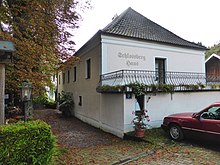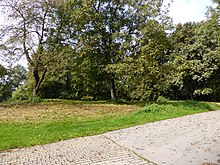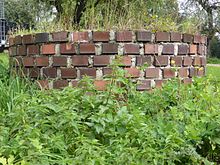Reichenberg Castle (parish churches)

The abandoned Reichenberg Castle was located in the district of the same name in today's district town of Pfarrkirchen in the Rottal-Inn district of Bavaria (Herzog-Heinrich-Str. 5).
History of Reichenberg Castle and Nursing Court
Reichenberg Castle is said to have been mentioned for the first time in a document around 800. What is certain is that after the Palatine line of the House of Ortenburger with Rapoto III. von Ortenburg on June 5, 1248 the Bavarian provincial dukes managed to acquire the area on the Rott against the bitter resistance of the diocese of Passau within a short time . In 1259 there is talk of a sale of the Ortenburg inheritance by the son-in-law and heir, Count Hartmann von Werdenburg , to the Wittelsbach family. The Hofmark Reichenberg had been owned by the Bavarian Duke Heinrich since 1260 . A peace treaty with the Diocese of Passau, with which an open war had broken out since 1257, was reached in 1262; in this Bishop Otto von Lonsdorf confessed to the duke all fiefs, which earlier Rapoto III. from the Diocese of Passau. The lordship of Massing was owned by the nobiles von Massing until around 1190 and was also acquired together with the castra Gern and Reichenberg before 1260 . Eggenfelden also seems to come from the inheritance of the Ortenburgers (1160 a Ministeriale comitis Rapotonis Ebo nomine de Etenvelt is mentioned as evidence ) and may have become Wittelsbach in 1259. The duke had gladly acquired the castrum from the nobilis Chuenrad de Lukpurch before 1260 . These acquisitions are confirmed in the partial letter from 1353, in which the three castra Gern, Reichenberg and Massing and the two markets Pfaffenhofen and Eggenfelden are named in the Rottal . The court was organized as early as 1279 and Rudiger Moroltinger was named as the first judge. Reichenberg Castle becomes the seat of the vicarage “an der Rott”. To round it off, the Ering - Erneck rule was acquired by Johann Landgraf von Leuchtenberg in 1377 . The Julbach rule was sold to the Wittelsbach family by the Counts of Schaunberg in 1382 .
In 1440 the rott court, which had become very extensive, was split up. Several judges at the Rott were named beforehand, such as Ruger the Moroltiger (1339), Heinrich de Lennberg (1370), Hans Rietter (1437), Hans Ruether (1439). In 1441 the court Reichenberg with the offices of parish churches, Osten and Birnbach is named; the Eggenfelden court includes the offices of Eggenfelden, Morntal and Massing. In 1440 the district judge Hans Puetzner zu Reichenberg is also documented and in 1441 Jobst Leonprechtinger is judge in the Eggenfelden court.
Reichenberg was administered together with Hofmark Degernbach, which is mentioned from 1435. The Counts of Baumgarten (and also other noble and ecclesiastical lordships) were able to take possession of individual lower court districts in the Reichenberg nursing court (Höhenberg seat, Hofmark Obergrasensee , Untergrasensee seat ).
The Reichenberg Nursing Court included the Triftern Office , the Pfarrkirchen Office, the East or Sulzbach Office and the Birnbach Office , which in turn were divided into various chairpersons . Care was initially granted for one year, but could then be extended. This was the case with Georg Tusslinger in 1533 and with Cunrad Soyter in 1563. Heronimus Lenberger was the ducal keeper on Reichenberg for life. Wilhelm Graf von Ortenburg, who was the nurse on Reichenberg in 1526, was given the office all his life , and not longer (an indication that the Duke wanted to prevent the office from becoming hereditary, something similar was noted when the care was given to the Countess von Berchem ). Reichenberg was also responsible for the maintenance of the Eggenberg district court until 1599, only then was it raised to its own maintenance. One groom was first for Burghut responsible, so the castle had to keep and allowed no one can stay without the knowledge of the sovereign. Then he also had to protect the residents of the nursing office from external violence, as the court lord he was responsible for compliance with the law, had to collect taxes and duties and, in the event of war, also raise the men who were fit for military service.
Often the care was also given to women and in these cases served as pension and care institutions. In order to exercise the office, a subject fit for office had to be found and, best of all, married. Women were never allowed to deal with care, at most in a subordinate position (bridge toll income, co-workers, etc.). From 1666 to 1669, Barbara Sibilla Kolb, née Truchseß von Höfingen and widow of the late carer Andreas Kolb, held the office with her two sons and a daughter. From 1687–1688 Maria Irmengard Kolb, née von Stuben , and her mother-in-law Barbara Sibille Kolb took care of this, but they had to let the caretaker from Eggenfelden carry out the official use. 1738–1767, Maria Theresia Anna Countess von Seinsheim, the widow of the deceased carer Johann Franz Maximilian von Seinsheim, is the owner of the care benefit. The last owner of nursing care was Maria Anna Countess von Minuzzi, maid of the Electress of Bavaria Maria Leopoldine of Austria-Este . When she left court service and got married to Maximilian Graf von Berchem, she was given the pleasure of nursing by Reichenberg. When care was terminated in 1799, the court pay office assigned her a main enjoyment instruction until 1803 and then from 1804 on a pardon by grace.
The nurse was entitled to various auxiliary officers to carry out his duties, e.g. B. a judge who acted as the carer's private clerk. In 1587, for example, a Stephan Gremb was appointed as district judge. The nursing administration in the nursing home Reichersberg was vacant from 1630 to 1634 and from 1649 to 1666, since the nurse himself officiated here, in 1674/75 the nurse officiated with a clerk . Between 1687 and 1688 the keeper of Eggenfelden also administered the Reichenberg care. In 1700 the first maintenance commissioner is recorded in Reichenberg (Ignaz Hormayr). This was a senior civil servant who was particularly active when the carer was unable to attend. From the 18th century onwards, the maintenance commissioner had to be a qualified lawyer. The nursing commissioner was vacant from 1718–1737; the nurse himself was in office again. In 1764, Margareta Hölzl, widow of the nursing commissioner Franz Anton Hölzl (1737–1764), was given the nursing commissioner's office with her son; however, it had to provide a subject fit for office. The Reichenberg Nursing Court was dissolved in 1799. The last maintenance commissioner was Johann Anton Freiherr von Gugler, who then became a district judge in parish churches.
The castle and the later built Reichenberg Palace had been in the possession of the Bavarian dukes since 1260 and the seat of the caretaker of Reichenberg and Degernbach. In 1648 the castle was taken by the Swedes and burned down except for the manor house. The rebuilt castle also served as an apartment for the carer until the nursing court was relocated to Pfarrkirchen in 1799; the dukes used the castle as a hunting lodge. The castle was demolished in 1804.
Reichenberg Castle then and now
The facility lay on a south-facing mountain spur, which was protected on three sides by the natural sloping terrain; on the north side, a hill is connected over a ridge. At the narrowest point of the ridge, the castle was built in the area of a small chapel from the 18th / 19th centuries. Century secured by two neck ditches . After crossing the ridge, the inner of the two trenches curves around the slope flanks. Today the Herzog-Heinrich-Straße leads to the former castle grounds, a separate walkway leads to the chapel.
As one can see from the depiction of Michael Wening from 1721, the electoral castle Reichenberg was a mighty complex located on a hill. A simple one-storey building that gives a defensive impression is attached to a three-storey hall with a half- hipped roof . From there a wall stretches to a small church. Next to it is a square tower crowned with battlements. Another building forms part of the wall that leads back to the Palas.
The so-called Schlossberghaus was built after 1804 with the stone material of the castle, which for a long time stood almost alone on the Reichenberg. Today a mountain restaurant has been set up here. The building is a two-storey solid construction with a hipped roof, which was built in the early 19th century. Next to it is a small path chapel with a gable roof . This comes from the 18th or early 19th century. Between the Schlossberghaus and the chapel there is still the former fountain of Schloss Reichenberg, which is the only part that has been preserved. In the 20th century, numerous newly built houses were added to the Burgstall, which meant that Reichenberg grew closer and closer to parish churches.
literature
- Johannes Pätzold: The prehistoric and early historical area monuments of Lower Bavaria . (Material booklets on Bavarian prehistory, series B, volume 2). Verlag Michael Lassleben, Kallmünz 1983, ISBN 3-7847-5090-7 , p. 291.
- Ilse Louis: Parish churches. The nursing courts Reichenberg and Julbach and the rule Ering-Frauenstein. (= Historical Atlas of Bavaria, part of Old Bavaria, issue 31). Verlag Michael Laßleben, Munich 1973, ISBN 3-7696-9878-9 .
Web links
Individual evidence
- ↑ Johannes Pätzold: The prehistoric and early historic terrain monuments of Lower Bavaria , p. 291
- ↑ Homepage of the Schossberghaus
Coordinates: 48 ° 26 '8.1 " N , 12 ° 57' 24.6" E





